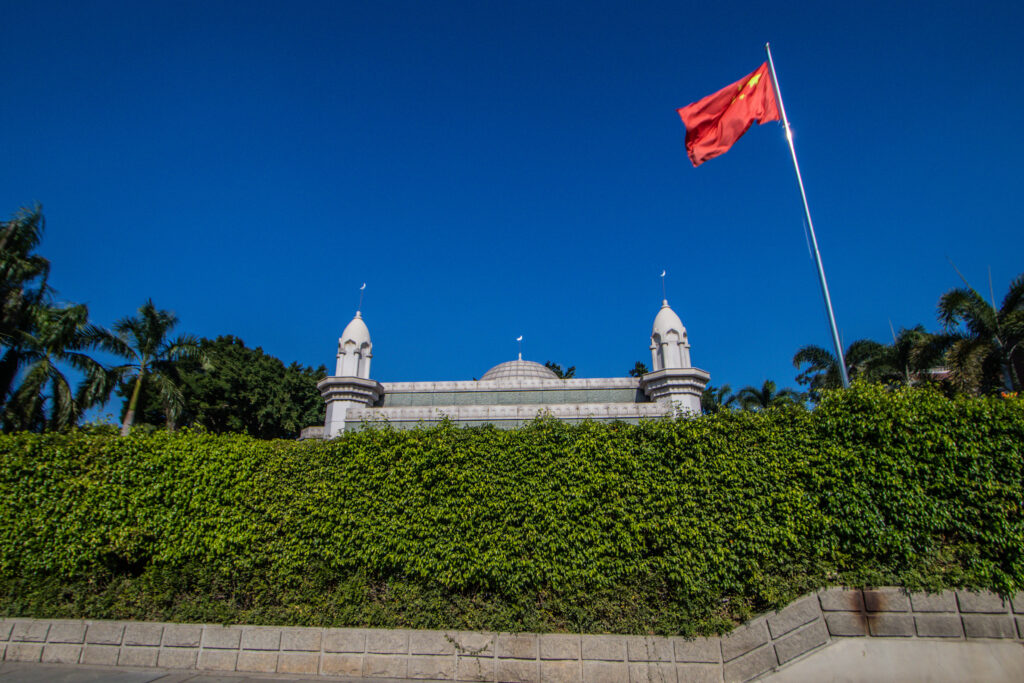The first images of Chinese mosques with their domes torn off began circulating in 2018. Soon, other news reports highlighted rare, isolated instances of public protest, in which Hui Muslims came out onto the streets to resist demolitions or forced renovations of their mosques.
Under a drive to remove aesthetic signs of the so-called ‘three changes’ — Arabisation, Saudization and pan-halalification — ‘Arabic’-style mosques across the country have had their minarets shortened and domes removed, replaced with often incongruous pagoda-style roofs. Muslim restaurants have been required to remove their Arabic-language ‘halal’ signs and replace them with a Chinese-language equivalent. In early 2024, reporting by the Financial Times and a groundbreaking report by Human Rights Watch, have laid bare the nationwide-wide scale of these renovations.
Such renovations are the most visible aspects of an unfolding campaign to secure the ‘sinicisation’ of Islam, a campaign intended to remove signs of foreign influence and ensure that Islam in China is appropriately ‘Chinese in orientation’. The term ‘sinicisation of religion’ was first used by Xi Jinping in 2015, not long after the inauguration of the 2014 ‘Strike Hard Against Violent Terrorism’ campaign in the Xinjiang Uyghur Autonomous Region.
Following the country’s ethnonational turn under President Xi Jinping, non-Han identities have been increasingly perceived as a potential threat to national stability and ethnic minorities and religious groups are policed for their adherence to a state-defined standard of ‘Chineseness’.
The concept of ‘sinicisation’ and the idea that the ‘sinicisation’ of a particular group marks a level of civilisation has a long history in Chinese-language political discourse. But Xi’s redeployment of the term needs to be understood in the context of recent state campaigns that have sought to explicitly link loyalty to the Party with being Chinese and a sharp move toward assimilationist policies directed at non-Han ethnic and religious minorities.
In the rhetoric of the current campaign, Islam is implicitly a foreign religion. To be made safe, Islam must adapt to Chinese circumstances.
State narratives around the sinicisation of Islam suggest that an appropriately Chinese form of Islam hadevolved over the long history of Islam in China. But in recent years, the infiltration of ‘foreign forms of Islam’ has caused an unacceptable deviation away from this old and appropriately sinicised Islam. The current campaign is justified as a course correction, necessary to safeguard the Chinese nation and the proper path of development, and to ensure that extremist tendencies are pre-emptively nipped in the bud.
The sinicisation of Islam is underpinned by similar logic to the mass repression and detention of Uyghurs and other Islamic minorities in Xinjiang, though the campaign has been less overtly coercive in its implementation. With the state definition of violent incidents in Xinjiang as acts of Islamic extremism and routine acts of Islamic observance by Uyghurs and other minorities seen as potential indicators of extremist tendencies, work to rectify Islamic observance across China has acquired a particular urgency.
Surveillance and detention of Muslims across Xinjiang has meant increased attention to Islamic communities elsewhere in China. It remains important to acknowledge that there have been no mass arrests to date and communities beyond Xinjiang retain some scope to practise their faith in a way that is impossible inside Xinjiang.
The scale and transformative intent underpinning the sinicisation campaign has been slow to emerge, partly as the policy has been implemented at different timelines in different regions.
The forced renovations of mosques have been accompanied by a series of interventions into the lives of mosque communities. This has ranged from measures to ensure that religious education is in line with ‘socialism with Chinese characteristics’, to bringing ‘excellent traditional Chinese culture’ into mosques and to revising translations of religious texts into Chinese. It has also entailed restrictions on teaching Arabic, controlling the appointments of religious professionals and tightened governance of mosques and the China Islamic Association.
While much less visible to the wider public, these changes have deep significance for affected communities — dictating how homes should look, how Islam should be taught and how believers should worship. Of particular concern to many are the restrictions on teaching children about Islam, which remains tightly intertwined with Hui heritage — a potentially existential threat to cultural transmission.
The nature of these interventions reveal that sincisation is about ensuring the supremacy of the Chinese Communist Party, Party ideology and a Party-backed vision of ‘Chineseness’. It is about control, and, in pursuit of control, has gone far beyond the initial campaigns to remove aesthetic markers perceived as ‘foreign’. The quiet closure of large numbers of mosques across Ningxia, justified in the name of reducing ‘burden’ on the communities supporting them, suggests that ultimately there is little place for religion or cultural plurality in Xi’s vision for a modern Chinese community.
Hannah Theaker is Lecturer in History and Politics at the University of Plymouth, United Kingdom.

